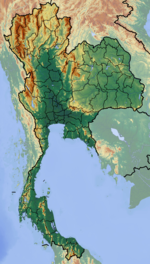Tou Yuan or Nou Tou Yuan or Tuhuan (Chinese: 陀垣 or 陁垣 or 耨陀垣[1]: 305–6 ) was a short-lived ancient Mon political entity that existed on the coast near the present Chanthaburi in Thailand.[1]: 267 It was formed following the fall of Funan in the early 7th century and was later annexed to Dvaravati in 647.[1]: 269
Tou Yuan Kingdom | |||||||||
|---|---|---|---|---|---|---|---|---|---|
| Early 7th century – 647 | |||||||||
Location of Tou Yuan in present–Thailand | |||||||||
| Capital | Si Mahosot? | ||||||||
| Historical era | Post-classical era | ||||||||
• Formation | Early 7th century | ||||||||
• First sent tribute to China | 644 | ||||||||
• Annexed to Dvaravati | 647 | ||||||||
| |||||||||
| Today part of | Thailand | ||||||||
It was the Mon's settlements,[2]: 90 bordered with Dvaravati in the west, to the north met the Lavo Kingdom, and to the southeast met Chen-li-fu Chantaburi,[1]: 267 which later became part of Chenla.[1]: 267. 289
Location
editAccording to the details given in the Chinese records, Tou Yuan is southwest of Linyi in the middle of the sea and is bordered by Duohuoluo 墮和羅 (Dvaravati) to the southeast. It is three months and several days journey from Jiaozhi (交趾).[3]: 8 Geoffrey Goble speculates it is possibly on the Malay peninsular, whereas Lawrence P. Briggs located it in the east of Thailand near the present-Chanthaburi.[1]: 267
Society
editTou Yuan became the vassal of Dvaravati in 647.[1]: 269 It sent envoys to the Chinese court several times between 644 and 647. In 647, Tou Yuan present a white parrot and baros ointment as tributes to China, yet they requested horses and copper bells and there was an edict granting them both. Its king's surname is Chashili 察失利 and his given name is Pomopona 婆末婆那.[3]: 8
The land is without silkworms and mulberry. They make clothes of lustrous white and rosy dawn-colored cloth.[3]: 8 They have rice paddies, barley, hemp, and legumes. They raise white elephants, cows, sheep, and swine.[3]: 16 Their custom is that everyone lives in elevated buildings (樓) called ‘dry pavilions’ (ganlan 干欄).[3]: 8
When their relatives die they do not eat in their room. After cremating the corpse they pick out the cremains and wash them in a pool. Thereafter, they will eat.[3]: 16
References
edit- ^ a b c d e f g Lawrence Palmer Briggs (1950). "The Khmer Empire and the Malay Peninsula". The Far Eastern Quarterly. 9 (3). Duke University Press: 256–305. doi:10.2307/2049556. JSTOR 2049556. Archived from the original on 26 April 2024.
- ^ Wang Gang-wu (1958). "The Nanhai Trade: A Study of the Early History of Chinese Trade in the South China Sea" (PDF). Journal of the Malaysian Branch of the Royal Asiatic Society. 31 (182): 3–135.
- ^ a b c d e f Geoffrey Goble (2014). "Maritime Southeast Asia: The View from Tang-Song China" (PDF). ISEAS – Yusof Ishak Institute. p. 1–19. ISSN 2529-7287.
